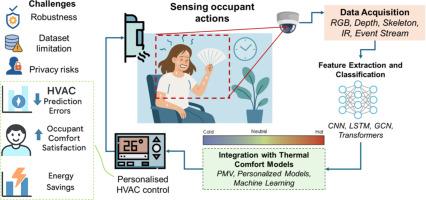基于计算机视觉的乘员动作识别的热舒适评价综述
IF 7.6
1区 工程技术
Q1 CONSTRUCTION & BUILDING TECHNOLOGY
引用次数: 0
摘要
室内热舒适对居住者的生理健康、心理状态和生产效率有显著影响。传统的评估方法,如问卷调查或生理测量,往往是侵入性的,并且存在反馈延迟。随着计算机视觉技术的进步,基于动作识别的热舒适评估已经成为一种有前途的非侵入性和实时的方法。然而,现有的综述对该方法的关键方面仍然不清楚或不完整,例如,热适应行为和热感觉之间的映射、可用的数据集、基础技术和端到端工作流程。因此,本文系统地追溯了热舒适评估的发展,并综合了基于动作识别的方法的最新研究,提供了他们的方法和管道的全面说明。我们对相关文献进行了系统的检索,然后对适应性行为、现实世界部署和隐私问题的行动识别模型进行了深入的分析。我们批判性地研究了视觉数据采集、特征提取和行为-舒适映射、分类算法以及将识别行为与暖通空调控制策略相结合的文献。一些研究表明,将动作识别集成到暖通空调控制系统中可以减少热舒适预测误差,提高乘员满意度,实现节能。我们进一步讨论了当前的部署挑战、数据集构建和隐私问题,概述了当前技术的局限性和未来研究的方向。综上所述,本文综述为将行为识别集成到智能建筑系统中提供了理论基础和实践指导,为以乘员为中心的节能环境控制奠定了基础。本文章由计算机程序翻译,如有差异,请以英文原文为准。

Thermal comfort assessment based on occupants’ action recognition using computer vision - A review
Indoor thermal comfort has significant impacts on occupants’ physiological health, psychological state, and productivity. Conventional assessment methods, such as questionnaires or physiological measurements, tend to be intrusive and suffer from feedback latency. With advances in computer vision, action-recognition–based thermal-comfort assessment has emerged as a promising approach that is both non-intrusive and real time. However, existing reviews remain unclear or incomplete on key aspects of this approach, for example, the mapping between thermal-adaptive behaviours and thermal sensation, the available datasets, and the underlying techniques and end-to-end workflow. Accordingly, this article systematically traces the development of thermal-comfort assessment and synthesizes recent studies on action-recognition–based approaches, providing a comprehensive account of their methods and pipelines. We conducted a systematic search of the relevant literature and then performed in-depth analyses of action-recognition models for adaptive behaviours, real-world deployment, and privacy issues. We critically examine the literature on visual data acquisition, feature extraction and behaviour-to-comfort mapping, classification algorithms, and the integration of recognized actions with HVAC control strategies. Some studies indicate that integrating action recognition into HVAC control system can reduce thermal comfort prediction error, increase occupant satisfaction and achieve energy savings. We further discuss current deployment challenges, dataset construction, and privacy concerns, outlining both the limitations of the state of the art and directions for future research. Taken together, this review provides a theoretical foundation and practical guidance for integrating action recognition into intelligent building systems, laying the groundwork for occupant-centric, energy-efficient environmental control.
求助全文
通过发布文献求助,成功后即可免费获取论文全文。
去求助
来源期刊

Building and Environment
工程技术-工程:环境
CiteScore
12.50
自引率
23.00%
发文量
1130
审稿时长
27 days
期刊介绍:
Building and Environment, an international journal, is dedicated to publishing original research papers, comprehensive review articles, editorials, and short communications in the fields of building science, urban physics, and human interaction with the indoor and outdoor built environment. The journal emphasizes innovative technologies and knowledge verified through measurement and analysis. It covers environmental performance across various spatial scales, from cities and communities to buildings and systems, fostering collaborative, multi-disciplinary research with broader significance.
 求助内容:
求助内容: 应助结果提醒方式:
应助结果提醒方式:


